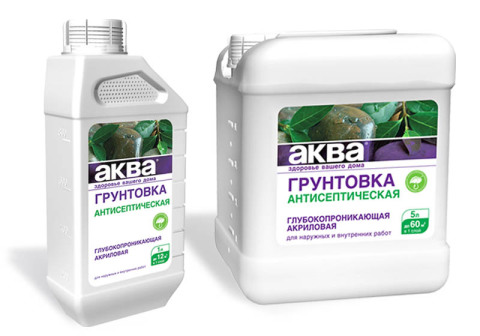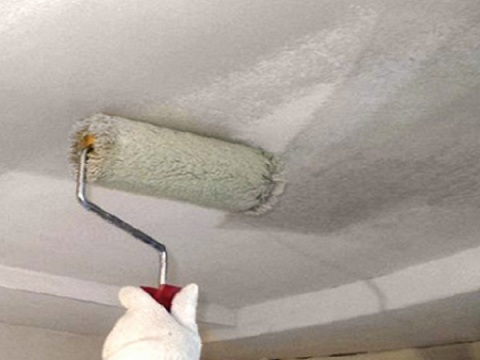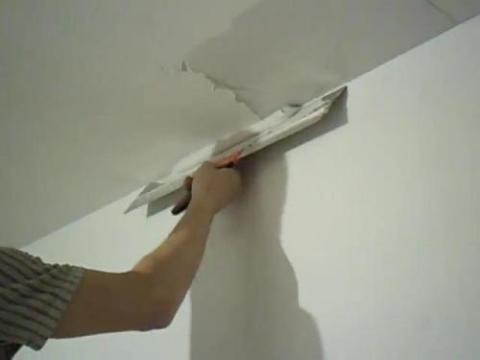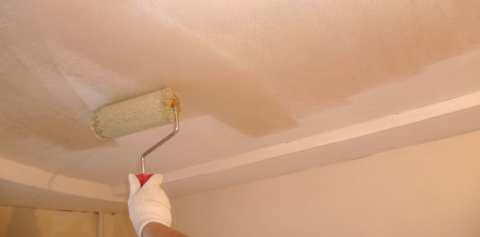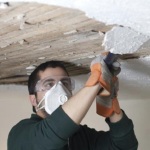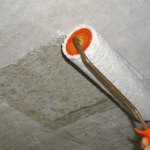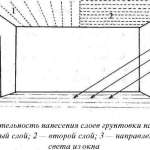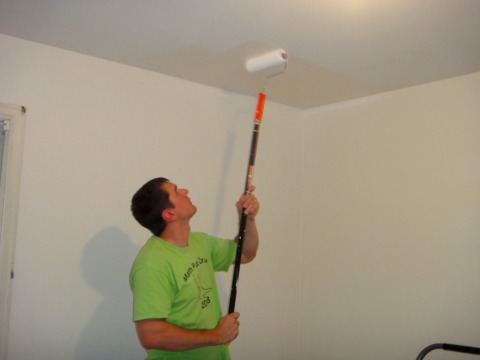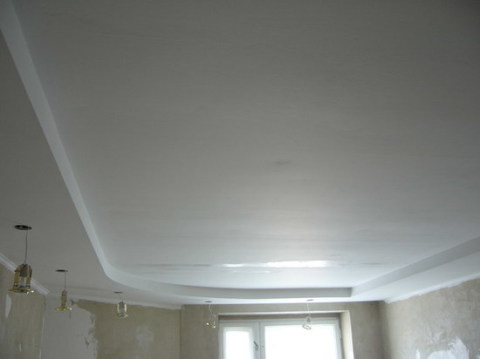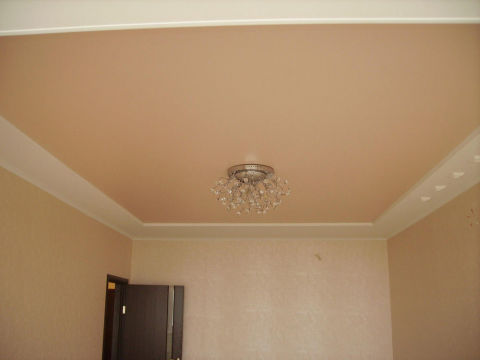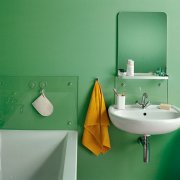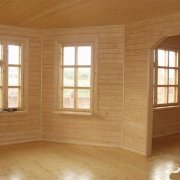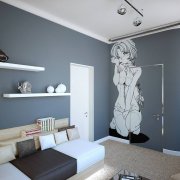How to paint the ceiling without stains: the choice of paint, methods, performance
Many do not know how to paint the ceiling without divorces and all kinds of irregularities, they rely on their own experience and knowledge. However, often this is not enough, and the final appearance of the ceiling does not meet the wishes and preferences.
From this article you can learn all about how to properly paint the ceiling, and do it in a professional manner and as simple as possible.
The content of the article
Proper preparation of the ceiling
In order to learn how to paint the ceiling without streaks, the first step is to properly perform surface preparation:
| Stage | Description and recommendations |
| Removing plaster and previous coatings | Using a steel spatula, it is necessary to clean the ceiling of the old coating or plaster (seeHow to clean the wall of plaster without problems). If the ceiling coating has traces of mold or mildew, cleaning must be carried out right up to the concrete floor. |
| Antiseptic Treatment | Using antiseptic solutions, it is possible to process both the entire ceiling and exclusively previously affected areas. If the room has high humidity, regardless of its initial condition, it is necessary to treat the entire ceiling with an antiseptic. |
| Surface priming | Using a primer, apply it to the entire surface of the ceiling after the antiseptic has completely dried (seeHow to primer the ceiling: we understand in stages). This is necessary so that in the future the starting putty has better adhesion. |
| Leveling the surface and applying the first layer | Further, it is necessary to level the surface well in order to give maximum evenness. To do this, apply the starting layer of putty. After the putty is completely dry, primer the surface again. |
| Putty finishing coat | We remove the dust with a vacuum cleaner and apply a finishing layer of putty. For these purposes, a special acrylic putty “Finish”. We polish the surface, remove dust with a vacuum cleaner. Then primer again using a roller or a suitable brush. |
| Completion of preparation | At the last stage we carry out painting. The number of layers depends on the quality of the selected paint. |
Important: in order to paint the ceiling with your own hands, you must step by step follow the recommendations listed in the table, strictly in stages, and using special tools such as a spatula, building level, various-sized rollers, brushes, sandpaper.
- Removing Previous Coating
- Ceiling surface preparation
- Use of a roller with a long handle
- Application of the first coat of primer
- Spatula leveling
Tip: in order to reduce dust and dirt during the preparation of the surface by an order of magnitude, after cleaning the surface, it is recommended to use a vacuum cleaner.
If you want to learn more about the surface preparation process, we recommend watching the video in this article.
Painting
Today, there are several varieties of paints:
- Water-based paint. The base is presented in the form of an emulsion, which includes water and small particles of polymers. Such paint is easy to apply and after evaporation of the water forms a thin and reliable film. In order to learn how to spread water-based paint for the ceiling, it is enough to read and follow all the instructions specified by the manufacturer on the package or in the instructions for the purchased product;
- Chalk. This coating is made of water and chalk. Paint is one of the cheapest and most affordable. Despite the possibility of using this option, it has a lot of disadvantages, such as: the impossibility of eliminating pollution, the inability to produce wet cleaning of the coating, fragility, loss of original color, the appearance of cracks and bumps;
- Acrylic. It is distinguished by its impeccable durability. The composition includes such components as: water and polymers, which when mixed form a fairly reliable and durable base, which after solidification has an excellent appearance and uniform structure;
- Latex. The composition of the paint base for ceilings includes synthetic latex. The advantages of the composition include the rapid application and drying of the surface. It will take no more than one hour to completely dry each layer. Also, this paint has a smooth surface - a film that is easy to care for.
- Primer Coating Sequence
- Necessary tools for work
- Paint Technology
Photos of materials and various designs will help you become more familiar with the process of work and painting.
Important: if you do not know how to paint the ceiling with a water-based paint without stains, we recommend that you carefully read and follow the next step-by-step guide.
Stain-free paint instruction
To perform these works, we need the following materials and tools:
- Long hair roller (seeRoller for painting the ceiling: how to choose) A short pile is not suitable, because it is not able to gain a sufficient amount of a coloring composition. Foam devices during operation do not give a perfectly smooth surface, form bubbles and stains;
- Roller tray suitable for size. In such a tray, not only mixing of the paint will be carried out, but also a preliminary rolling of the roller. This is necessary so that during the work on the ceiling there are no stripes and irregularities;
- Paint with the necessary composition. The best option is acrylic based paint.
Important: before starting work, carefully read the tips and recommendations indicated by the manufacturer on the packaging with paint. Many manufacturers recommend diluting it a little before applying it with water.
Ceiling painting, basic rules:
- Each layer should be of the same thickness, and the surface must be painted with the same paint, from the same manufacturer and a strictly defined consistency;
- The ceiling must be painted in at least two or three layers;
- Each layer is applied perpendicular to the previous one. The last layer should be perpendicular to the window. This is necessary so that even with minor irregularities, they are invisible and lost behind the sun's rays;
- Each coat is painted at a time. It is impossible to start work and, without completing the layer, stop, because at the place where the paint has already dried, with a fresh continuation there will be a noticeable and unavoidable joint;
- Assess the quality and evenness of the painting, it is necessary exclusively at an angle;
- If you forgot to paint a small area, and the paint has already partially dried, you can not paint it, as this will result in joints, stains and bumps. Leave this area next time.
Tip: if you want to make a ceiling of a certain color, it is quite possible that you will have to mix the paint with a special building dye in a certain ratio - proportion, until the desired result is achieved. In order that in the future you do not have to mix and select this color again, we recommend that at the first stage, immediately mix the necessary amount of paint to paint the entire surface of the ceiling, and in the required number of layers.
What to do if streaks and streaks still appear?
If, in spite of all your efforts and efforts, stains and stripes on the ceiling as a result of painting appeared and they are very noticeable, we recommend that you repeat the whole process. To do this, you will need a grinding machine, which needs to be treated the entire surface and, after repeated cleaning, proceed to painting again.
Important: if you cannot achieve a perfectly even coverage by your own efforts, we advise you to turn to professionals for help or give preference to suspended ceilings. Suspended structures look even more stylish, modern, original, and also distinguished by their durability and the ability to choose the design and color scheme for a favorable combination with the general style of the room.
Tip: if the price of paint is important to you, choose cheaper water-based and chalk compositions. Despite their budget, they are also suitable for painting.
If before you paint the ceiling, you will familiarize yourself with the technology of surface preparation, as well as choose a high-quality paint base, then you will probably be able to do all these work yourself, and the final result will look neat and professional.


